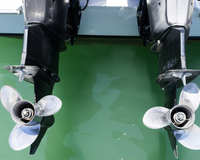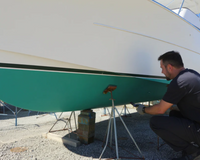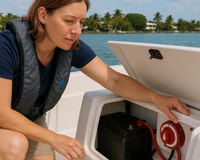A Step-By-Step Guide to Replacing Boat Anodes
If you own a boat, it’s important to replace the anodes regularly. Anodes are also known as "zincs" or "martyrs". The purpose of these sacrificial pieces of metal is to prevent corrosion from taking place in your boat. Let Brian in our tech department show you how easy it is to replace the zincs on your boat.
Rudder and Shaft Anodes:
- Streamlined Zinc Shaft Anodes
- Martyr CMP07612Z Zinc Rectangular Hull Plate Anode W/O Straps
- Sea Shield Rudder Plate 1-3/4 X 3/8
Boat anodes, commonly referred to as "zincs," are essential components in protecting your boat from galvanic corrosion. This guide will provide you with a step-by-step process for replacing boat anodes, including essential tools and equipment, the best materials and methods, as well as tips and tricks for an efficient replacement process.
Importance of Replacing Anodes
Replacing your boat's anodes is crucial to prevent galvanic corrosion, which occurs when two dissimilar metals are submerged in water and an electrical current flows between them. Anodes are made of a more reactive metal, which means they will corrode before other metals on your boat. By regularly checking and replacing anodes, you can save both time and money on costly boat repairs.
When to Replace Anodes
Anodes should be replaced when they're worn down to 50% of their original thickness. It's recommended to inspect your anodes at least twice per year, and possibly more frequently if your boat is moored in brackish or saltwater.
Tools and Equipment Needed:
- Wrench set
- Socket set
- Wire brush
- Replacement anodes
- Marine anti-seize compound
- Ruler or calipers (for measuring anode thickness)
Materials and Methods
Select high-quality anodes: When purchasing replacement anodes, opt for high-quality materials such as zinc, aluminum, or magnesium. The type of anode you choose will depend on the water your boat frequents:
- Zinc: for saltwater
- Aluminum: for saltwater, brackish water, and freshwater
- Magnesium: for freshwater only
- Locate the anodes on your boat: Common locations for anodes include the hull, rudder, propeller shaft, and trim tabs. Refer to your boat's owner's manual for all anode locations.
- Remove old anodes: Using the appropriate wrench or socket, remove the fasteners holding the anodes in place. If the anodes are difficult to remove, try gently tapping them with a rubber mallet to loosen them.
- Clean the mounting surfaces: Once the old anodes are removed, use a wire brush to clean any corrosion or debris from the mounting surfaces.
- Apply marine anti-seize compound: To prevent seizing and make it easier to remove anodes in the future, apply a marine-grade anti-seize compound to the fasteners.
- Install new anodes: Position the new anodes on the mounting surfaces and secure them with the fasteners. Do not overtighten, as that may cause the anode to crack or break.
- Measure and record the thickness of the new anodes: Using a ruler or calipers, measure the thickness of the new anodes. Record this measurement and the date of installation to easily track when it's time for future replacements.
Tips and Tricks
If you're unsure about the anode type needed for your boat, consult a marine professional or your boat's owner's manual. Using the incorrect anode type could lead to increased corrosion.
- Always keep spare anodes and replacement hardware onboard. This will save time and money, should you need to replace anodes unexpectedly.
- Schedule regular inspections of your anodes to ensure they're in good condition. This is especially important after long periods of your boat being stored or not in use.
- Record the date of each anode inspection and replacement in a logbook. This will help you keep track of your boat maintenance schedule more efficiently.
By following this guide and implementing a proper maintenance schedule, you can protect your boat from costly damage, extend its lifespan, and enjoy the open water with peace of mind.






